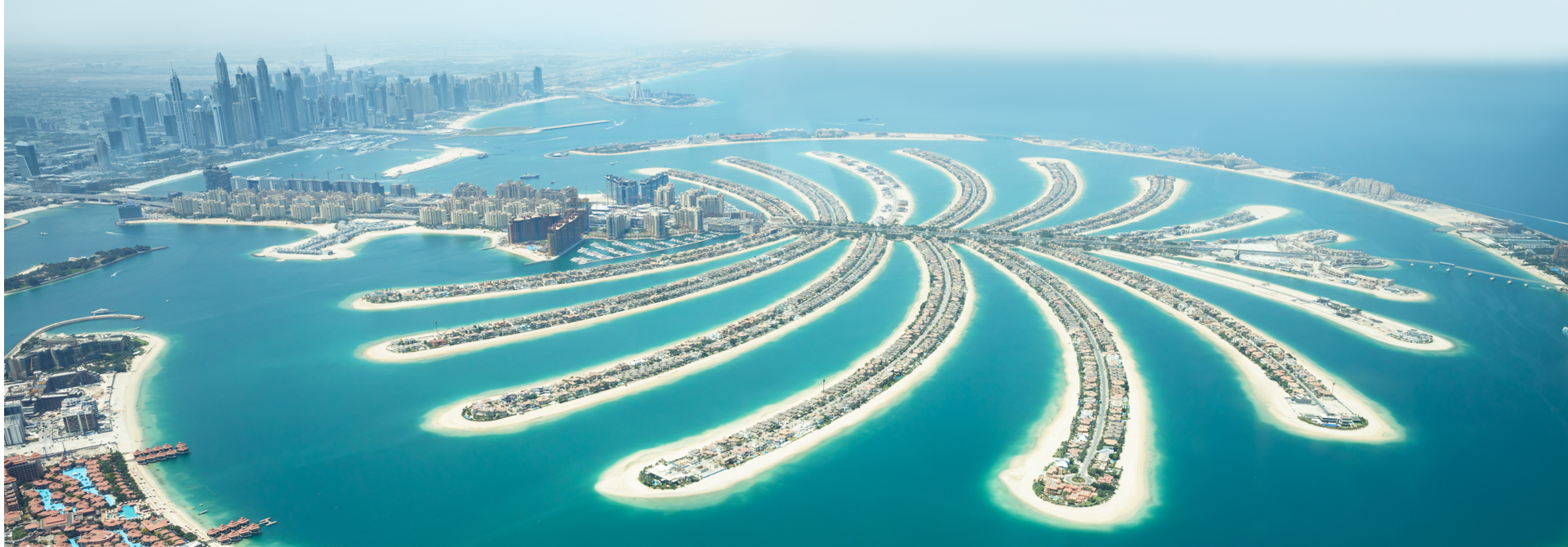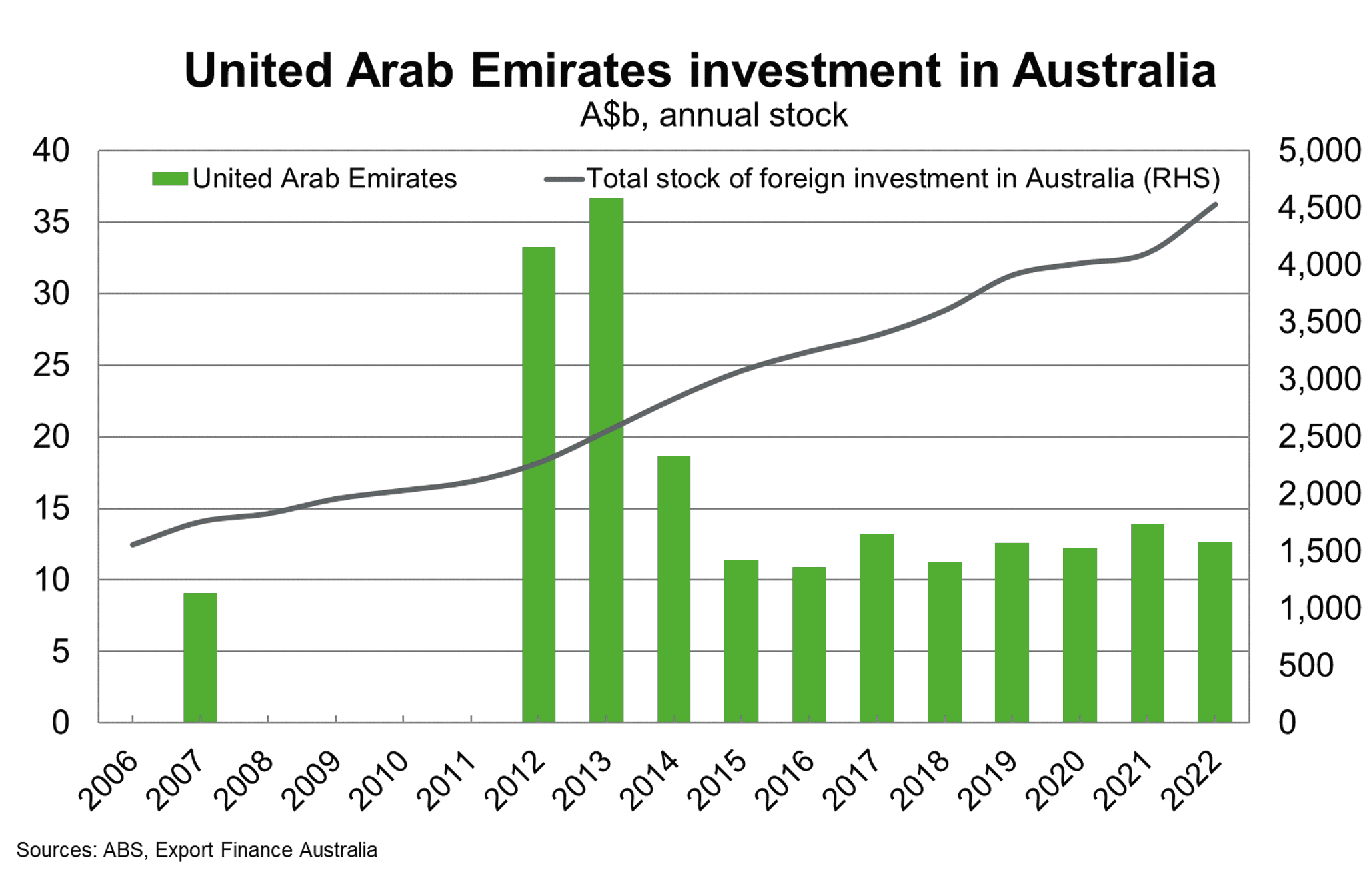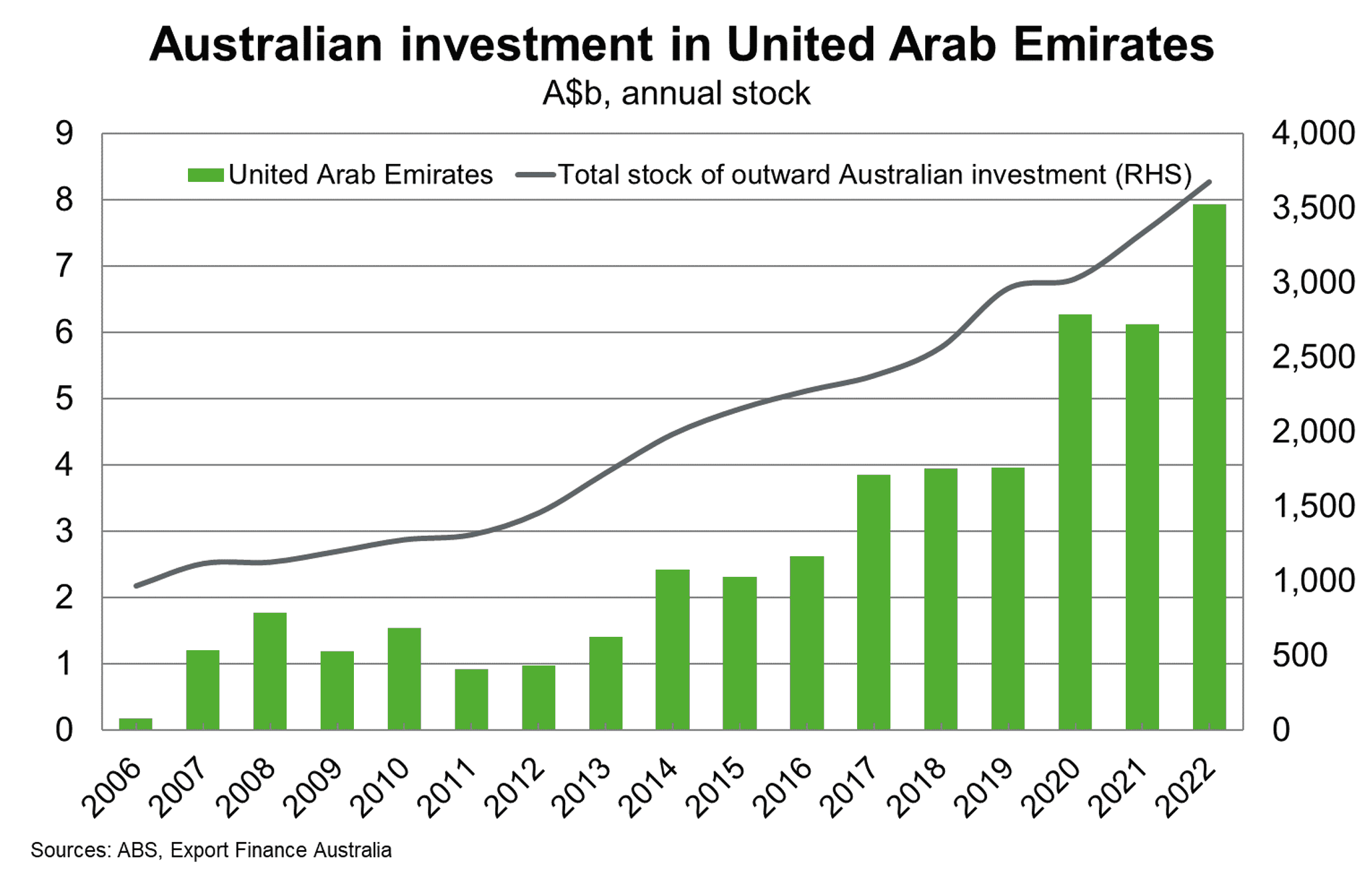
United Arab Emirates
United Arab Emirates
Last updated: January 2024
The United Arab Emirates (UAE) is the third largest economy in the Middle East, behind Iran and Saudi Arabia. The UAE has higher real GDP growth, per capita incomes, business climate rank and creditworthiness score compared to MENAP neighbours (Middle East, North Africa, Afghanistan and Pakistan). The UAE is a major hub for Australian businesses looking to expand into the MENAP region. Most of the UAE is highly dependent on energy exports to drive output and incomes; that said, the UAE has been diversifying its economy towards tourism and services sectors, and aims to increase development of decarbonisation and lower-carbon projects.

The above chart is a cobweb diagram showing how a country measures up on four important dimensions of economic performance—per capita income, annual GDP growth, business climate rank and creditworthiness. Per capita income is in current US dollars. Annual GDP growth is the five-year average forecast between 2024 and 2028. Business climate is measured by the World Bank’s 2019 Ease of Doing Business ranking of 190 countries. Creditworthiness attempts to measure a country's ability to honour its external debt obligations and is measured by its OECD country credit risk rating. The chart shows not only how a country performs on the four dimensions, but how it measures up against other countries in the region.
Economic Outlook
The IMF estimates that growth in the United Arab Emirates (UAE) decelerated to 3.4% in 2023 from 7.9% in 2022 amid lower oil production and softer global oil prices. Non-hydrocarbon sectors likely grew more than 4% in 2023, continuing the strong momentum seen in real estate developments, tourism, financial services and construction. The UAE continues to attract foreign inflows of capital and labour amid social and business-friendly reforms and its regional haven status. Capital and labour flows are helping to boost the external payments position and lift real estate prices. Rising labour participation rates, supported by government initiatives such as the unemployment insurance scheme, are boosting incomes. Fiscal policy measures, such as the introduction of the corporate income tax in June 2023, and tighter monetary policy, are reducing financial stability risks but weighing on growth.
The outlook remains positive. The IMF expects growth to pick up to 4% in 2024, assuming no escalation in geopolitical tensions. Oil production and exports are poised to recover modestly. Broader trade and investment flows will be bolstered by the UAE’s membership to BRICS (an intergovernmental organisation comprising Brazil, Russia, India, China, South Africa and other countries) as of January 2024. The government’s focus on economic diversification will continue to support investment in non-hydrocarbon sectors.
External risks to growth include an escalation of geopolitical tensions, a decline in oil demand, reduced global trade and tourism due to slower than expected global growth, and higher-for-longer interest rates. That said, the UAE’s healthy fiscal buffers mitigate these risks.
Long term growth hinges on the Dubai Economic Agenda, so-called ‘D33’. If successfully implemented, the D33 program will raise productivity in the industrial sector, promote export growth, increase foreign investment inflows and enhance the business environment. Other strategies included in the UAE’s future roadmap include expanding investment in innovation and advanced technology sectors and adopting greater use of renewable energy.

The UAE has the second-highest per capita income (US$50,600) in the MENAP region after Qatar and is expected to rise to about US$60,000 by 2028. Household incomes have been somewhat volatile due to the UAE’s dependence on oil. But incomes should stabilise as economic diversification reduces exposure to shocks. Inequality remains an issue—according to data from the World Inequality Database—the top 10% of adult income earners in the UAE earn 50% of the country’s total income.

Country Risk
Country risk in the UAE is low. The OECD country credit grade is 2. All three major private credit ratings agencies have investment grade sovereign ratings. This means that there is a low likelihood that the UAE is unable/unwilling to meet its external debt obligations. Abu Dhabi’s economic weight and financial strength is a key support for other emirates in the UAE. Most laws are based on Islamic principles.


The risk of expropriation is low. According to the US Investment Climate Statements, there have been no reported cases of expropriation in the recent past. There are, however, no rules covering compensation if expropriation were to occur, and it would only occur if it were in the public interest to do so or there were any other compelling developments.

Political risk in the UAE is low to moderate, and includes risks related to escalation of regional geopolitical tensions that could hinder trade and investment.

The UAE scores highly on indicators of government effectiveness, rule of law, regulatory quality and control of corruption, implying strong governance and institutional frameworks on a standalone basis and relative to other MENAP countries. However, as in many MENAP countries, the UAE scores in the lowest quartile for voice and accountability.

Bilateral Relations
The UAE is Australia’s largest trading partner in the MENAP region and 19th largest overall in 2022. Major Australian exports to the UAE in 2022 included aluminium ores and concentrate, oil-seeds and oleaginous fruits, meat and vegetables. Fertilisers, petroleum, copper and jewellery were Australia’s biggest imports from the UAE in 2022. The UAE is a major hub for Australian businesses looking to diversify exports into the Middle East due to its favourable transport, financial and communications infrastructure. Potential export opportunities in the UAE include aviation, food and beverages and water solutions.

Student enrolments continued their downward trend from their peak in 2009. Notwithstanding competition from international institutions and the rise in quality from the domestic system, education remains a key sector offering strong export potential, given Australian universities such as the University of Wollongong, Murdoch University and Curtin University all have campuses in the UAE.
Tourist arrivals picked up further in 2023 following another year of open international borders. But they remain below pre-pandemic levels. A competitive Australian dollar and another year of recovery in international travel should support demand for Australian tourism, and broader services exports, in 2024.


UAE investment in Australia stood at $12.6 billion in 2022, remaining broadly steady since 2015. Sovereign wealth funds contribute the most towards investment in Australia. For example, the Abu Dhabi Investment Authority, the 4th largest sovereign wealth fund in the world, has invested in ports, TransGrid electricity network and Queensland Motorway project. Australian investment in the UAE amounted to $7.9 billion in 2022, having grown steadily over time. Australian companies use Dubai as a regional base for operations, given the emirate’s comprehensive transport, financial and communications infrastructure, though opportunities also exist in the renewable energy sector.


Useful links
Department of Foreign Affairs and Trade
United Arab Emirates Country Brief
Austrade
United Arab Emirates Market Profile
